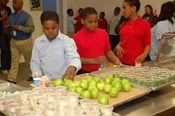Just because healthful foods are available in school cafeterias doesn't mean children are going to eat them, but in some cases, the very presence of such foods as whole fruit may actually prompt kids to make healthier choices, even if fruit is never selected.
A study by researchers at Cornell's Center for Behavioral Economics in Child Nutrition Programs (BEN Center) found that the mere presence of applesauce and fruit cocktail on the school lunch line sent students to seek out sugary snacks, increasing the number of cookies, ice cream bars and Little Debbie snack cakes they purchased, while green beans and bananas inspired them to make more healthful choices.
"The impacts of offering a single vegetable or fruit may have significant implications for the whole meal," said study co-author Andrew Hanks, a postdoctoral researcher for the BEN Center.
"Even though these students did not take a fruit or vegetable, either in a meal or as a separate item, their choices of the less healthy a la carte items were still affected by the presence of fruits and vegetables," said BEN Center co-director and study co-author David Just. Brian Wansink, the other co-director, is also a co-author.
The study, published in the April edition of the Agricultural and Resource Economics Review, analyzed school lunch purchase data from two schools in upstate New York.
The authors hypothesized that the children's choices could be the result of the "priming effect." The sweet nature of applesauce and fruit cocktail might have led the children to be drawn to other items with greater sugar content, while the green beans and bananas could cause the student to think about healthful foods.
Although the exact foods that trigger behavior may differ from cafeteria to cafeteria, the principle is that relatively more healthful items trigger healthier choices and vice versa.
The findings build upon previous studies by Just and Wansink that have found that environmental cues such as visibility, convenience and accessibility can affect behavior in systematic ways.
"Trigger foods may fly under the radar, influencing choice without overtly drawing the attention of the decision maker, but they can have substantial effects on the nutritional content of the food selected," Wansink said.
Just added that the behavioral anomaly could be exploited to lead children to eat better. "This information can be most useful for food service directors as they strive to identify which options will help students make the most healthful choices," he said.
The research was supported by the U.S. Department of Agriculture's Economic Research Service and Food and Nutrition Services.







